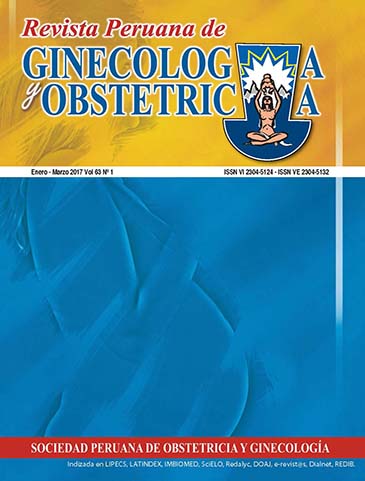Plasma angiopoietin-2 in the second trimester as a predictor of the development of preeclampsia
DOI:
https://doi.org/10.31403/rpgo.v63i1959Abstract
Objective: To establish the usefulness of plasma concentrations of angiopoietin-2 in the second trimester of pregnancy as a predictor of the development of preeclampsia. Design: Case-control study. Setting: Hospital Central “Dr. Urquinaona”, Maracaibo, Venezuela. Participants: Nulliparous pregnant women. Interventions: 504 nulliparous women between 17-20 weeks pregnant who assisted to prenatal control were studied; 41 developed preeclampsia and were considered cases (group A) and 463 did not develop preeclampsia and were considered controls (group B). Main outcome measures: General characteristics, plasma angiopoietin-2 concentrations and prognosis efficacy. Results: There were no significant differences in maternal age, gestational age and systolic and diastolic blood pressure at the moment of ultrasound evaluation (p = ns). Gestational age at diagnosis of preeclampsia in group A was 35.0 +/- 3.2 weeks. There were significant differences in plasma angiopoietin-2 concentration values between patients in group A (26.0 +/- 4.7 ng/mL) and patients in group B (19.7 +/- 5.9 ng/mL; p < 0.0001). A cut-off value of 22 ng/mL had a value under the curve of 0.77, a sensitivity of 75.6%, a specificity of 58.5%, a positive predictive value of 14.2% and a negative predictive value of 96.5%. Conclusion: Plasma angiopoietin-2 concentrations in the second trimester of pregnancy could predict the development of preeclampsia.Downloads
Downloads
Published
2017-04-19
How to Cite
Reyna-Villasmil, E., Mejía-Montilla, J., Santos-Bolívar, J., Torres-Cepeda, D., Reyna-Villasmil, N., & Fernández-Ramírez, A. (2017). Plasma angiopoietin-2 in the second trimester as a predictor of the development of preeclampsia. The Peruvian Journal of Gynecology and Obstetrics, 63(1), 11–17. https://doi.org/10.31403/rpgo.v63i1959
Issue
Section
Artículos Originales
















